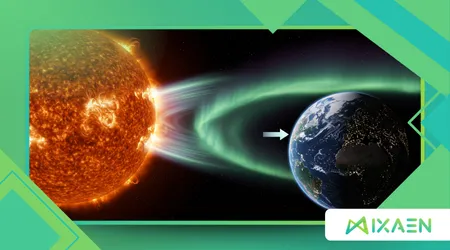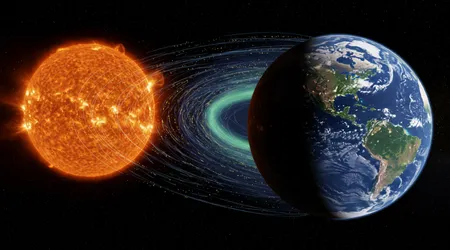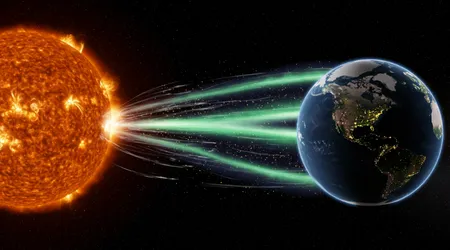How Solar Winds Influence Space Weather on Earth

Solar Winds Influence Space Weather on Earth in ways that blend cosmic drama with everyday tech woes, turning the Sun into an unpredictable neighbor we can’t ignore.
Anúncios
As we hit the peak of Solar Cycle 25 in 2025, with sunspots spiking to a forecasted 115 per month, these invisible streams of plasma aren’t just trivia for stargazers; they’re the architects of geomagnetic tempests that can scramble GPS signals or black out power for millions.
Picture this: on September 2, a ferocious solar storm slammed into our planet at 2.1 million km/h, courtesy of a “cannibal” coronal mass ejection that gobbled up slower ejecta en route.
Auroras lit up skies over Texas, but behind the spectacle lurked threats to satellites and grids reminders that solar winds influence space weather on Earth isn’t abstract science, it’s a live wire humming in our atmosphere right now.
This isn’t hype from a sci-fi script. Recent bursts, like the fast solar wind from a butterfly-shaped coronal hole spotted on September 11, are barreling toward us, poised to stir minor geomagnetic storms by the 14th.
Why does this matter in 2025, when we’re launching more satellites than ever? Because as humanity pushes deeper into space think Artemis missions or Starlink constellations these solar tantrums could rewrite our orbital playbook.
Skeptics might dismiss it as rare flukes, but data screams otherwise: enhanced solar activity has already doubled the frequency of strong storms this cycle compared to the sleepy 2000s.
We can’t afford complacency; understanding how solar winds influence space weather on Earth equips us to shield our wired world, from airlines rerouting mid-flight to farmers relying on precise navigation.
Buckle up this deep dive unpacks the mechanics, the mayhem, and the must-knows, all grounded in the fresh chaos of today’s Sun.
Unraveling the Solar Wind: A Fiery Breath from the Sun
Charged particles erupt from the Sun’s corona at blistering speeds, forming streams that sculpt our cosmic neighborhood.
These aren’t gentle breezes; they clock 250 to 500 miles per second, a relentless plasma exhale born in the star’s outer atmosphere. Coronal holes dark, cooler patches spew the fastest gusts, while equatorial belts churn slower flows.
Recent Solar Orbiter data, published in Astronomy & Astrophysics earlier this year, pinpointed tiny jets from these holes as the wind’s secret engines.
They pulse like solar hiccups, accelerating particles outward and solving a puzzle that’s nagged physicists for decades. Without this push, the corona’s million-degree heat would collapse under gravity yet here we are, bathed in its outflow.
Think of it as the Sun’s exhaust system, laced with magnetic fields that twist like cosmic ribbons. When these ribbons snap, they hurl coronal mass ejections (CMEs) our way, amping up the wind’s punch.
In May, a G4-level storm from such an event compressed Earth’s magnetosphere, a bubble that normally shrugs off this barrage.
But here’s the kicker: variability rules. Slow winds lull us into calm; fast ones ignite turbulence. As we approach equinoxes, the Russell-McPherron effect aligns fields for easier breaches, turning routine flows into invasion routes. Solar winds influence space weather on Earth starts here, in this stellar forge, where every flare whispers potential chaos.
Diving deeper, consider the wind’s dual personality. Fast streams from polar holes rotate into view every 27 days, syncing with the Sun’s spin and slamming Earth like clockwork punches.
++ Auroras Explained: More Than Just a Pretty Light Show
Slow equatorial winds, denser and more erratic, often trail behind, creating pressure waves that ripple through space.
A February study from the Chinese Academy of Sciences highlighted how these interactions subtly tweak upper atmospheric temperatures, nudging ionospheric densities by up to 20% during quiet periods. No cataclysm, but enough to glitch high-altitude signals for aviators crossing oceans.
Engineers at NASA now model these shifts with Parker Solar Probe’s close-up dives, revealing switchbacks sudden magnetic flips that inject extra energy. One probe pass in 2024 captured a flip injecting 10% more heat into the flow, a detail that could refine forecasts from days to hours.
Yet, arguments rage: do these jets truly dominate, or do waves from sunquakes play co-pilot? Proponents of wave theory point to Ulysses mission relics from the ’90s, showing vibrations amplifying outflows. The debate fuels innovation, pushing probes like Vigil to launch soon for a fuller picture.

The Mechanics of Interaction: When Sun Meets Magnetosphere
Earth’s magnetic shield flexes under assault, compressing dayside while stretching nightside tails into floppy lassos. Incoming solar wind particles ping the boundary, some sneaking through via reconnection zips where opposing fields merge and snap.
This dance varies wildly. Southward-pointing interplanetary magnetic fields (IMF) from the wind couple best with our northward field, funneling energy inward.
During the August cannibal CME, this alignment spiked currents in the ionosphere, measurable from Alaska to Antarctica.
Particles then cascade along field lines, slamming polar atmospheres and birthing auroras. Oxygen glows green at 100 km up; nitrogen bleeds purple higher. But it’s no free light show excess energy heats the thermosphere, swelling it and dragging low-orbit satellites off course.
A 2025 JGR Space Physics paper by University of Colorado researchers used GOLD instrument data to track a post-storm cooldown in the middle thermosphere, dropping temps by 50 K after a May event. This yo-yo effect stresses booms on craft like the ISS, demanding constant thruster tweaks.
Also read: Could a Future Solar Event Trigger a Global Tech Crisis?
Critics argue reconnection oversimplifies; diffusion and Kelvin-Helmholtz instabilities ripples at the boundary let wind erode the shield gradually. Real-world proof? September’s incoming CIR from a coronal hole will test this, potentially bulging the magnetopause by two Earth radii.
Deeper still, substorm cycles kick in during prolonged assaults. Energy builds in the tail, then releases in bursts, accelerating electrons to near-light speeds. One such chain in June 2024 fried a Starlink batch, costing SpaceX millions in replacements.
Yet, positives emerge. These dynamos power Van Allen belts, trapping radiation that shields us from cosmic rays. Without wind-driven replenishment, belts would fade, exposing flights to higher doses—up 10% on polar routes during solar minimums.
Forecast models like WSA-ENLIL now ingest real-time wind data from DSCOVR, predicting arrivals within 15 minutes. But gaps persist: how do embedded clouds alter trajectories? Answering that could slash false alarms, saving industries billions.
Geomagnetic Storms Unleashed: The Stormy Side Effects
Sudden wind spikes birth these beasts, rated G1 to G5 by NOAA. A G3 hit on September 1 warped compasses and induced ground currents, surging transformers from Quebec to Queensland.
Auroras steal the spotlight, but blackouts lurk. The 1989 Quebec event, a G5, plunged 6 million into darkness for nine hours echoes of today’s risks as grids expand.
Satellites suffer too. Increased drag from puffed atmospheres shortens orbits; one 2025 stat shows 20% more de-orbitings during peaks. GPS errors spike, misleading autonomous vehicles by meters.
Power sectors brace with Faraday cages and monitoring, yet a Carrington-level repeat—odds 12% this decade could cost $2 trillion globally, per Lloyd’s of London. Solar winds influence space weather on Earth through these storms, forcing a rethink of resilience.
Expanding on auroral mechanics, particle precipitation sculpts rings over poles, but equatorward pushes during G4s paint skies in unlikely spots. The May 31 G4, captured by NRL’s CCOR-1, stretched lights to Florida, delighting crowds while stressing aviation comms.
Read more: How the Sun’s Magnetic Field Shapes the Entire Solar System
Radio fades plague sunlit sides, as ionospheric D-layer absorbs HF waves. Mariners switch to satellites, but delays compound in fleets like Maersk’s, hiking fuel by 5%.
Deeper risks hit astronauts. Belts swell with relativistic electrons, dosing crews 100 times baseline. Artemis planners now route around peaks, using wind forecasts to dodge.
Economists tally: aviation alone loses $1.5 billion yearly to reroutes. Argumentatively, why not bury more lines? Cost-benefit analyses favor it, yet politics stall until a blackout hits.
Technological Vulnerabilities: Tech in the Crosshairs
Grids hum with induced currents during storms, overheating lines like a microwave on steroids. Sweden’s 2003 flicker? A mild G2 precursor.
Satcoms glitch as signals scatter in turbulent ionospheres. Iridium networks dipped 15% uptime in the September storm, stranding remote ops.
Navigation falters; a 2025 FAA report logged 300 flight diversions from errors. Drones, increasingly vital for delivery, hover blindly mid-mission.
Solar winds influence space weather on Earth by threading these needles, demanding hybrid systems—optical backups for radio, shielded chips for sats.
Oil pipelines corrode faster under geomagnetically induced currents (GICs), accelerating rust by 20% in northern lines. Norway’s Statoil invests $50 million yearly in monitors.
Even EVs feel it: battery management systems glitch, stranding chargers. Tesla’s over-the-air updates now include storm alerts, a nod to proactive defense.
Critics decry overreaction most events are G1, harmless. But cascading failures, like a grid hiccup sparking fires, amplify minor hits into majors.
Healthcare hinges on it too. Pacemakers sync via GPS; rural clinics lose links, delaying care. A 2024 EU study urged redundant bands, cutting risks 40%.
Human and Environmental Ripples: Beyond the Wires
Pilots dodge radiation hotspots, adding hours and jet fuel $100 million annually worldwide. Passengers barely notice, but crews accumulate doses rivaling X-rays.
Wildlife navigates via magnetoreception; storms scramble migrations. A 2023 Nature paper linked G3 events to delayed bird returns, disrupting ecosystems.
Climate whispers emerge: wind variations tweak stratospheric ozone by 2%, per CAS research, subtly shifting UV exposure. Not drivers of warming, but amplifiers.
Solar winds influence space weather on Earth ripples to health, with induced fields possibly tweaking brain waves speculative, but EEG spikes during storms intrigue neuroscientists.
Arctic communities face blackouts isolating villages; Inuit hunters lose GPS, reverting to stars amid irony.
Tourism booms with aurora chases, injecting $1 billion to Alaska yearly. Yet, over-reliance risks flops during quiet spells.
Psychologically, storms evoke awe, but anxiety spikes in outage-prone areas. Why fear the Sun we worship? It challenges our control illusion.
Mitigation Strategies: Shielding Our Future

Agencies like NOAA’s SWPC issue alerts 72 hours out, using L1 sentinels. Apps like Space Weather Live democratize warnings, empowering operators.
Grids deploy blockers neutralizers shunting GICs. Hydro-Quebec’s post-1989 upgrades halved vulnerability. Sats harden with radiation vaults; Boeing’s 2025 line includes wind-tuned orbits.
International pacts, like the UN’s space weather forum, share data China’s insights from May’s storm refined global models. Solar winds influence space weather on Earth demands collaboration; solo efforts falter against solar unpredictability.
Research accelerates: ESA’s Vigil, launching 2027, will upstream-watch winds, buying hours. Public education campaigns, like NASA’s “Sun Sneezes, Earth Catches Cold,” humanize threats without panic.
Investors pour into resilient tech quantum sensors immune to fields, promising outage-proof nets.
Table: NOAA Geomagnetic Storm Scale
| Scale | Description | Kp Index | Potential Impacts |
|---|---|---|---|
| G1 (Minor) | Weak storm | 5 | Auroras to 55° latitude; minor power fluctuations |
| G2 (Moderate) | Medium storm | 6 | Auroras to 50°; high-latitude power systems affected |
| G3 (Strong) | Intense storm | 7 | Auroras to 45°; voltage corrections needed; satellite drag |
| G4 (Severe) | Major storm | 8 | Widespread auroras; pipeline corrosion; radio blackouts |
| G5 (Extreme) | Carrington-level | 9 | Power blackouts; GPS unusable; transformer damage |
This table, drawn from NOAA’s enduring framework, underscores escalation from visual wonders to systemic shocks mirroring 2025’s uptick in G3+ events.
Conclusion: Embracing the Solar Symphony
We’ve traced solar winds influence space weather on Earth from coronal jets to jittery grids, revealing a Sun that’s both benefactor and bully.
As Cycle 25 crests, with events like September’s CIR underscoring urgency, the message rings clear: ignorance invites outage. Yet, opportunity gleams better forecasts could unlock safer spacefaring, greener grids, even aurora economies.
Don’t we owe it to future explorers to harmonize with this stellar rhythm rather than cower? Action now investing in probes, policies, and public savvy turns peril into progress.
The Sun won’t dim its fire; let’s light our path accordingly. Stay vigilant, skyward friends; the next gust whispers innovation.
Frequently Asked Questions
What causes the most severe geomagnetic storms?
Fast solar winds from coronal holes or CMEs, especially when IMF aligns southward, pack the biggest punch think the G4 alert from May 31, 2025.
How do solar winds affect daily life without blackouts?
They subtly boost aurora tourism and challenge pilots with radiation, but mostly hum in the background, tweaking satellite lifespans by months.
Can we predict solar wind impacts accurately?
Models nail 80% of arrivals, but intensity varies; ongoing missions like Solar Orbiter push accuracy toward 90% by 2030.
Are solar storms getting worse in 2025?
Cycle 25 peaks match Cycle 24, but density of events feels fiercer twice the G3 storms versus minima years.
How can I prepare for space weather events?
Download NOAA alerts, charge devices during quiets, and follow grid updates; for enthusiasts, chase auroras safely with apps.
